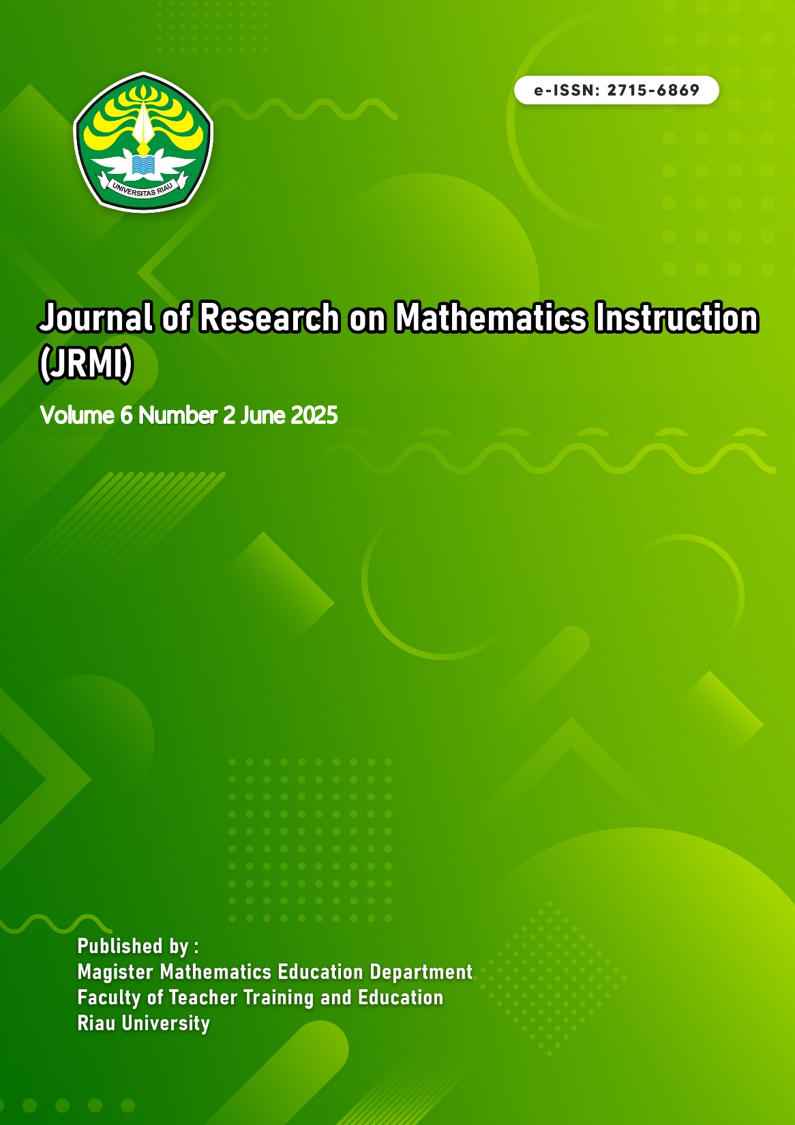An Analysis of Students' Conceptual Understanding in the Pythagorean Theorem Material
Abstract
Conceptual understanding is a fundamental skill and one of the primary goals of mathematics learning, where students are expected to comprehend concepts, explain relationships between concepts, and apply them in mathematical problem-solving processes. However, observations reveal that students generally exhibit relatively low levels of conceptual understanding when solving mathematical problems, mainly due to insufficient mastery of prerequisite materials. The purpose of this study is to analyze students' conceptual understanding of the Pythagorean Theorem based on the conceptual understanding indicators proposed by the National Research Council. The research method used is qualitative with a descriptive approach, specifically a hermeneutic phenomenological study. Qualitative data were obtained from document analysis, test results, and interviews involving 29 junior high school students. The findings based on five test items representing the conceptual understanding indicators show that the most mastered indicator by students is the ability to apply and use the concept appropriately. Conversely, the least mastered indicator is the ability to classify objects based on mathematical concepts.
References
S. W. Purwaningsih and R. Marlina, “Analisis Kemampuan Pemahaman Konsep Matematis Siswa SMP Kelas VII pada Materi Bentuk Aljabar,” J. Pembelajaran Mat. Inov., vol. 5, no. 3, pp. 639–648, 2022, doi: 10.22460/jpmi.v5i3.639-648.
M. L. Nasution and N. Hafizah, “Development of Students’ Understanding of Mathematical Concept with STAD Type Cooperative Learning Through Student Worksheets,” in International Conference on Mathematics and Mathematics Education 3 August 2019, 2020, pp. 1–6. doi: 10.1088/1742-6596/1554/1/012035.
M. E. Bete, S. Amsikan, and J. E. Simarmata, “Analisis Kesalahan Siswa Dalam Menyelesaiakan Soal Cerita Pokok Pembahasan Teorema Pythagoras,” MATH-EDU J. Ilmu Pendidik. Mat., vol. 8, no. 3, pp. 247–255, 2023, doi: https://doi.org/10.32938/jipm.8.3.2023.245-253.
E. D. S. Ritonga and L. R. Hasibuan, “Analisis Kesulitan Siswa dalam Pembelajaran Matematika Materi Teorema Pythagoras Ditinjau dari Minat Belajar Siswa di SMP Negeri 1 Rantau Utara,” J. Cendekia J. Pendidik. Mat., vol. 6, no. 2, pp. 1449–1460, 2022, doi: https://doi.org/10.31004/cendekia.v6i2.1341.
D. Khoerunnisa and I. P. Sari, “Analisis Kesulitan Siswa dalam Menyelesaikan Soal Teorema Phytagoras,” J. Pembelajaran Mat. Inov., vol. 4, no. 6, pp. 1731–1742, 2021, doi: 10.22460/jpmi.v4i6.1731-1742.
M. L. Hutapea, D. Suryadi, E. Nurlaelah, and M. E. Departement, “Analysis of Students’ Epistemological Obstacles on the Subject of Pythagorean Theorem,” J. Pengajaran Mat. dan Ilmu Pengetah. Alam, vol. 20, no. 1, pp. 1–10, 2015, doi: https://doi.org/10.18269/jpmipa.v20i1.36190.
Rusandi and M. Rusli, “Merancang Penelitian Kualitatif Dasar/Deskriptif dan Studi Kasus,” Al-Ubudiyah J. Pendidik. Dan Stud. Islam, vol. 2, no. 1, pp. 48–60, 2021, doi: https://doi.org/10.55623/au.v2i1.18.
I. Verina and D. Darhim, “Kemampuan Pemahaman Konsep Matematis Siswa SMP Kelas VIII Pada Topik Persegi Panjang,” AKSIOMA J. Progr. Stud. Pendidik. Mat., vol. 12, no. 2, pp. 2063–2076, 2023, doi: http://dx.doi.org/10.24127/ajpm.v12i2.7581.
R. A. Sari and W. A. Najwa, “Analysis of Student Errors in Completing Spotting of Round Numbers Based on Castolan Theory,” J. Sekol. Dasar, vol. 6, no. 1, pp. 55–59, 2021, doi: https://doi.org/10.36805/jurnalsekolahdasar.v6i1.1288.
R. D. Putri, “Analisis Kesalahan Siswa dalam Menyelesaikan Soal pada Materi Teorema Pythagoras berdasarkan Teori Kastolan,” vol. 11, no. 2, pp. 360–372, 2023, doi: 10.25273/jipm.v11i2.13266.
R. H. Soesanto, “A Review of Student Error Analysis in Linear Algebra Course Based on Kastolan Stage Model,” Fermat J. Pendidik. Mat., vol. 4, no. 1, pp. 1–12, 2021.
N. Ulfa, “Analisis Learning Obstacle pada Konsep Fungsi Komposisi dan Fungsi Invers dalam Pembelajaran Daring Ditinjau Berdasarkan Kategori Kesalahan AVAE (ARITH, VAR, AE, dan EQS),” Universitas Pendidikan Indonesia, 2021.
F. A. Putri and S. Erita, “Analisis Kemampuan Pemecahan Masalah Matematis Siswa Pada Materi Fungsi Komposisi,” Konstanta J. Mat. dan Ilmu Pengelatuan Alam, vol. 2, no. 1, pp. 32–39, 2023, doi: 10.59581/konstanta.v2i1.1897.
I. Herdiman, I. F. Nurismadanti, P. Rengganis, and N. Maryani, “Kemampuan Berpikir Kritis Matematik Siswa SMP Pada Materi Lingkaran,” PRISMA, vol. 7, no. 1, pp. 1–10, 2018, doi: https://doi.org/10.35194/jp.v7i1.213.
R. Rina and M. Bernard, “Analisis Kesalahan Siswa SMP Kelas VIII dalam Menyelesaikan Soal pada Materi Teorema Pythagoras,” J. Cendekia J. Pendidik. Mat., vol. 05, no. 03, pp. 2836–2845, 2021, doi: https://doi.org/10.31004/cendekia.v5i3.870.
N. Hasan, S. Subanji, and S. Sukorianto, “Analisis Kesalahan Siswa Kelas VIII dalam Menyelesaikan Soal Cerita Terkait Teorema Pythagoras,” J. Pendidik. Teor. Penelitian, dan Pengemb., vol. 4, no. 4, pp. 468–477, 2019, doi: 10.17977/jptpp.v4i4.12264.
Copyright (c) 2025 Journal of Research on Mathematics Instruction (JRMI)

This work is licensed under a Creative Commons Attribution-NonCommercial-ShareAlike 4.0 International License.






